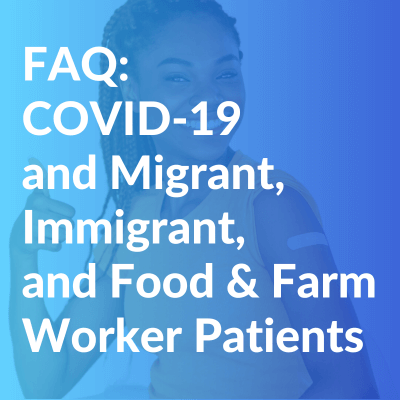COVID-19 Widens Health System Inequities, Threatening to Leave Migrants and Immigrants Behind: MCN Analysis and Resources

The spread of COVID-19 has dominated the headlines, but what does the virus mean for our most vulnerable populations? Migrants, asylum seekers, and immigrants already hit numerous barriers to get even basic health needs met; fear and anxiety over immigration status, ineligibility for health programs, cultural and language barriers, and a lack of financial resources are just some of the reasons they cannot or will not access care. As a result, many migrants and immigrants will likely miss out on early detection efforts that require navigation, often in English, of an overwhelmed health care system with which they’re unfamiliar. Farmworkers, even those who are geographically stable, run into similar barriers to care, as well as health care access limitations unique to low-wage laborers: without sick leave, many may opt not to take time off of work, as the weight of poverty propels them to work, regardless of illness.
The health care delivery systems that are tasked with providing triage and direct service need to develop and disseminate protocols immediately. As we learn more about the virus while simultaneously fielding a greater number of potential cases, health center staff need concrete support and direction to ensure that appropriate measures are taken to keep both patients and clinicians as safe as possible.
At a time when our health systems are unable to meet the growing demand for care as a result of COVID-19, the inequities in the health care system expand exponentially. At Migrant Clinicians Network, we are determined that our most vulnerable populations will not be left behind.
We call on health centers to prioritize vulnerable populations in their outreach and we call on our wider society to assure that access to testing and treatment are free and open for all, regardless of immigration status or health care coverage. When we leave a portion of our communities behind, we are all at risk.
Informing patients and the wider community with science-based information and tools is an important first step to support the health of migrant and immigrant communities during this pandemic. Here, we’ve compiled early resources about COVID-19 that may be relevant for clinicians and their migrant and immigrant patients.
Hesperian’s new fact sheets (as part of their excellent HealthWiki) in English, Spanish, and French can be utilized with patients. Hesperian says that fact sheets in Bahasa Indonesia, Bangla, Filipino, Haitian Kreyol, Hindi, and Vietnamese are forthcoming.
On March 19th, National COSH is hosting two webinars in English and Spanish, on workers’ rights, precautions, and actions: “How Workers are Impacted by the Coronavirus (COVID-19)” at 1pm Pacific and “Cómo lxs trabajadorxs se ven afectadxs por el Coronavirus (COVID-19)” at 3pm Pacific.
Connect Consulting Services, which focuses on health care emergency management, is hosting a webinar on March 25th entitled, “Fact vs Fiction: Planning For Coronavirus In Your Workplace.”
The American Public Health Association’s Get Ready page has patient-facing fact sheets in English, Spanish, and other languages.
HRSA’s new COVID-19 FAQs give some overview on the health center requirements around emergency preparedness as well as recommendations for communications from health centers.
NACHC’s new FAQ runs down a number of additional resources not covered here, specifically tailored for health centers.
This almost real-time map shows where COVID-19 cases have been reported, all over the world, which provides some perspective and allows for a visual understanding of the spread as it progresses.
The CDC’s archived webinar from last week provides a useful overview for clinicians: “Coronavirus Disease 2019 (COVID-19) Update—What Clinicians Need to Know to Prepare for COVID-19 in the United States.”
The New England Journal of Medicine has an article analyzing early cases in China which gives some clarity around how the virus works: “Clinical Characteristics of Coronavirus Disease 2019 in China.”
Please let us know what resources you’re relying on. Email Claire at chutkins-seda@migrantclinician.org.
Like what you see? Amplify our collective voice with a contribution.
Got some good news to share? Contact us on our social media pages above.
Return to the main blog page or sign up for blog updates here.
- Log in to post comments






